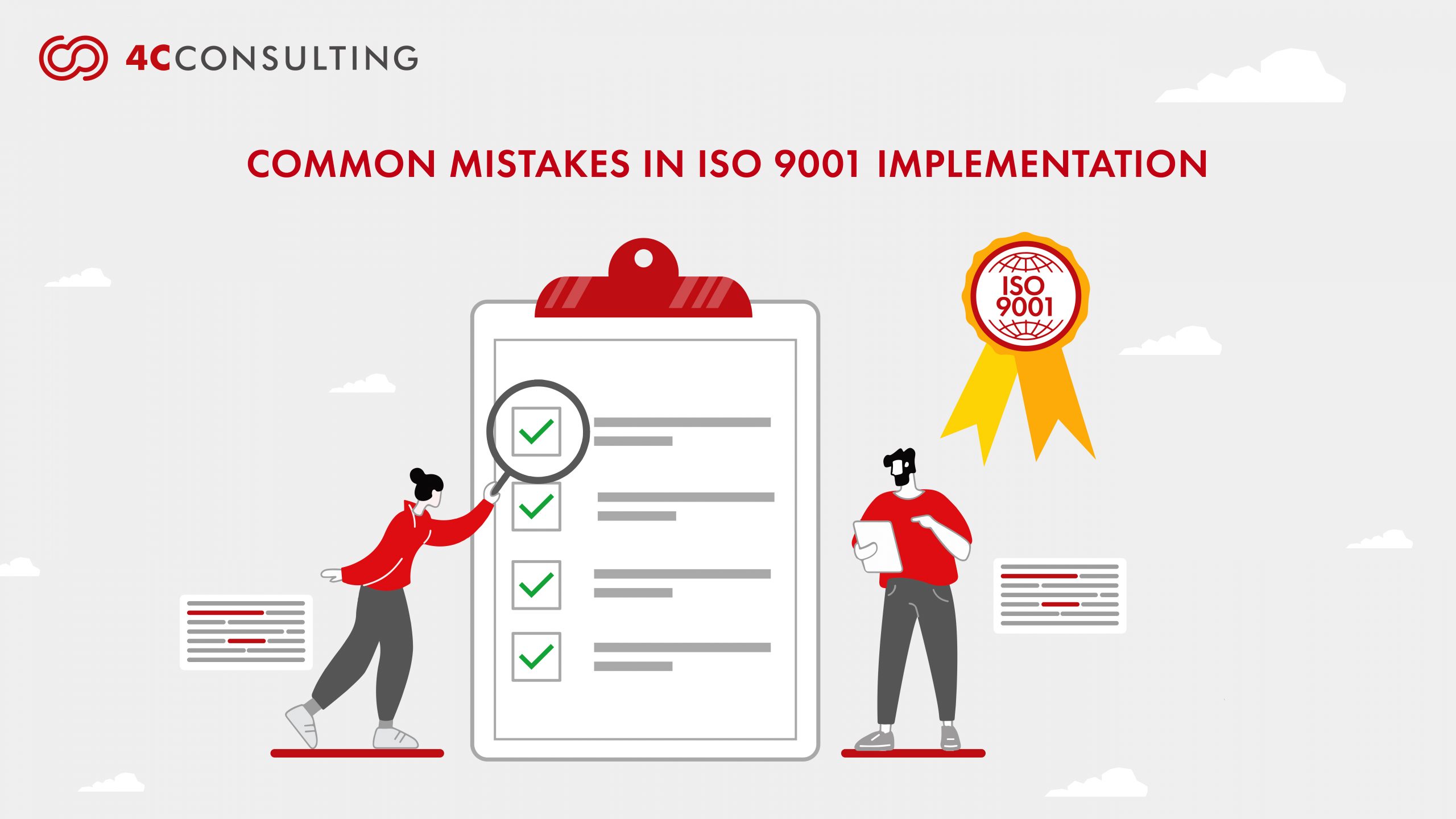
COMMON MISTAKES IN ISO 9001 IMPLEMENTATION AND HOW TO AVOID THEM
13th Sep, 2024
Did you know that nearly 30% of organizations fail their first ISO 9001 certification audit? The most common mistakes include poor preparation, lack of top management support, and weak internal audits, studies found that companies with weak internal audit practices are 50% more likely to encounter non-compliance during external audits. These setbacks often result in delays, higher costs, and the need for rework, Successfully navigating the ISO 9001 certification process requires a solid understanding of potential pitfalls. In this blog, we will discuss the most common mistakes made during ISO 9001 implementation and provide practical strategies to avoid them, helping your business achieve a smooth and successful certification journey.
.
WHAT IS ISO 9001?
ISO 9001 is a globally recognized standard for quality management systems (QMS), developed to ensure that organizations can consistently meet the needs of their customers and other stakeholders. It is based on several key principles such as customer focus, leadership, process-based approaches, and continuous improvement. ISO 9001 certification is applicable to any organization, regardless of size or industry, and helps businesses improve their quality management while enhancing customer satisfaction and organizational efficiency.
.
TOP 12 COMMON MISTAKES IN ISO 9001 IMPLEMENTATION
- Lack of Top Management Commitment: One of the most significant issues organizations face during ISO 9001 implementation is the absence of commitment from top management. Without active leadership involvement, the QMS might fail to align with the company’s strategic objectives. Often, companies treat the ISO 9001 certification process as a task delegated to the quality department, rather than integrating it into the broader business strategy.
Solution: Top management must actively participate in the ISO 9001 implementation. They need to take ownership, communicate objectives clearly, allocate appropriate resources, and regularly review progress. Engaging leadership helps foster a company-wide culture of quality that ensures long-term success and compliance.
- Poor Employee Training and Awareness: Another common mistake in ISO 9001 implementation is inadequate employee training. When employees are not sufficiently trained on ISO 9001 requirements, they often fail to understand their roles in maintaining the QMS, leading to non-conformities during audits. ISO 9001 awareness training is crucial to ensure employees understand their responsibilities in the quality management system.
Solution: Implement a comprehensive ISO 9001 training program for all employees, particularly those involved in key processes. Regular training sessions, workshops, and refreshers will ensure that staff are updated on ISO 9001 requirements and are able to contribute effectively to the QMS.
- Overemphasis on Documentation: While documentation is an integral part of the ISO 9001 certification process, focusing solely on documentation without understanding its application can be detrimental. Many companies make the mistake of prioritizing paperwork over the actual implementation of processes and improvements.
Solution: ISO 9001 Documentation should support practical implementation. Ensure that all documented procedures are understood and applied effectively in daily operations. Use documentation to drive improvements in business processes, rather than treating it as the final goal.
- Lack of Clear Objectives and KPIs: Failing to establish clear objectives and key performance indicators (KPIs) is another common issue in ISO 9001 implementation. Without well-defined objectives, it becomes challenging to measure the effectiveness of the QMS and make improvements.
Solution: Develop SMART (Specific, Measurable, Achievable, Relevant, Time-bound) objectives that align with your organization’s strategic goals. Regularly monitor ISO 9001 KPIs to track performance and make data-driven decisions for continuous improvement.
- Neglecting Internal Audits: ISO 9001 Internal audits are an essential tool for identifying gaps and non-conformities within the QMS. However, many organizations view these audits as a mere formality, neglecting their true value in maintaining compliance and driving improvement. Ignoring internal audits can result in major issues being uncovered only during the external certification audit.
Solution: Conduct regular internal audits to proactively identify areas of non-compliance and implement corrective actions. Use ISO 9001 gap analysis to review the system and ensure everything is in place for a successful certification audit.
- Not Engaging Employees in the Process: ISO 9001 implementation is not solely a management task. It requires employee involvement at all levels to ensure the system is effective. When employees are not engaged, they may not understand or follow the processes, leading to issues in maintaining compliance.
Solution: Involve employees in the ISO 9001 implementation process by including them in developing procedures, decision-making, and process improvements. Regular communication about how the certification impacts their roles will encourage active participation and accountability.
- Inadequate Management Review and Follow-Up: Management reviews are essential for ensuring the effectiveness of the QMS. However, many companies either skip these reviews or fail to follow up on the findings, resulting in missed opportunities for improvement.
Solution: Schedule regular management reviews that focus on the performance of the QMS, including audit results, customer feedback, and overall achievement of objectives. Ensure that follow-up actions are taken to address any issues identified during the review process.
- Failing to Integrate ISO 9001 into Daily Operations: A common mistake organization make is treating ISO 9001 as a separate project rather than integrating it into their daily operations. This can lead to inconsistencies between documented procedures and actual practices, causing non-conformities during audits.
Solution: Ensure that the QMS is embedded into the day-to-day activities of the organization. Every process, procedure, and performance measure should be aligned with ISO 9001 and followed consistently by all employees. This integration strengthens the system and ensures sustainable quality improvement.
- Misinterpreting ISO 9001 Requirements: Misunderstanding or misinterpreting the standard’s requirements can lead to implementation issues. Companies may overlook important clauses or fail to apply certain requirements, which can result in non-compliance and certification delays.
Solution: It’s critical to fully understand ISO 9001 requirements. Work closely with an ISO 9001 consultant to clarify any uncertainties, ensuring that all applicable requirements are met. A consultant can help guide your organization through the complexities of the standard.
- Ignoring Change Management: Organizations often fail to adapt their QMS as processes, personnel, or regulations change. Ignoring change management can lead to outdated systems and non-compliance with the standard’s requirements.
Solution: Implement a formal change management process as part of your QMS. This ensures that the system remains updated and aligned with changes in operations, technology, or regulatory requirements. Review and revise processes regularly to maintain ongoing compliance.
- Inadequate Resource Allocation: Organizations sometimes underestimate the resources needed for a successful ISO 9001 implementation. Lack of time, budget, or personnel can lead to incomplete implementation and delays in certification.
Solution: Plan resource allocation carefully, ensuring that you have the required budget, time, and personnel to develop and maintain your QMS. Regularly evaluate the resources to make adjustments as needed for continuous improvement.
- Neglecting Customer Feedback: Customer feedback is a valuable component of ISO 9001 implementation. However, many organizations overlook this feedback in their quality management process, preventing them from addressing critical customer satisfaction issues.
Solution: Use customer feedback to identify areas for improvement and to enhance your products and services. By incorporating feedback into your QMS, you not only meet ISO 9001 certification requirements but also build stronger customer relationships.
Avoiding these common mistakes is key to a successful ISO 9001 implementation. By ensuring top management involvement, providing thorough ISO 9001 training, conducting regular internal audits, and engaging employees, organizations can build a strong QMS that enhances quality, efficiency, and long-term compliance. Proper planning, resource allocation, and continuous improvement are critical to achieving and maintaining ISO 9001 certification. For businesses facing challenges in implementing ISO 9001 or needing expert guidance, working with an experienced ISO 9001 consultant can streamline the process, helping your organization meet all the necessary requirements and ensuring certification success.
.
WHY CHOOSE 4C CONSULTING TO ENSURE A SUCCESSFUL ISO 9001 IMPLEMENTATION?
Implementing ISO 9001 can be a complex journey, but 4C Consulting simplifies the process with over 15+ years of expertise in ISO consulting. Our team of experienced consultants and IRCA-certified auditors has successfully guided more than 3,000 businesses across various industries, ensuring efficient ISO 9001 certification. We provide comprehensive consultancy, training, and implementation services tailored to your specific needs, delivering over 30,000+ man-days of consulting and 20,000+ hours of training. Beyond certification, we focus on continuous improvement by integrating quality tools like LEAN, Six Sigma, and TQM into your processes. With partnerships with 50+ global certification bodies and a proven track record of success, 4C Consulting is your trusted partner in achieving certification. contact us today to start your path toward ISO 9001 certification success.
